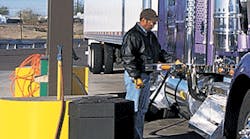The transition to ultra-low sulfur diesel is being blamed for shortages and record-breaking prices seen in the Rocky Mountain region, although to what extent is unclear. The record-breaking prices in the region underscored the effects of the ULSD transition combined with seasonal diesel consumption from irrigation equipment in the agriculture-rich region, the region’s isolation from major petroleum pipelines and a heat wave that sparked power outages that temporarily halted refining.
The Oil Price Information Service (OPIS) said yesterday that Midwest farmers were using “an enormous amount” of diesel to run irrigation equipment to prevent crops from withering under oppressive heat. OPIS said some truckstops along the I-80 corridor limited truckers to just 50-75 gallons per purchase, with some trucking companies advising their drivers to avoid filling up in Colorado.
Suncor Energy announced on June 27 it completed $445 million worth of upgrades to its Commerce City, CO refinery so that it could produce ULSD. Finished fuel products in the region rely heavily on local refineries since it is isolated from the rest of the nation’s fuel distribution infrastructure. According to one independent truckstop in Loveland, CO, the two Suncor refineries in the area have had problems ever since.
“Our major refineries are two that are owned by Suncor,” Ron Mock, assistant general manager of Loveland, CO-based Johnson’s Corner truckstop told FleetOwner. “They spent over $400 million to refit their refinery, but that equipment isn’t working as promised. I’ve had some ULSD come in, but from other refiners and I’m not looking [for ULSD]. I’m getting whatever I can find.
“A lot of [fueling stations] are on allocation,” Mock continued. “I was on a 75-gallon limit yesterday for three hours until we received a truck with more fuel. The mom and pop stations will have a harder time getting trucks.”
Mock said the truckstop’s diesel price is set on a load-by-load basis on any diesel that comes in—ULSD or not. Today, prices averaged around $3.40. “I’ve managed to procure fuel if I keep the prices high, but there’s no profit on it [for us] right now.”
“ULSD average rack prices jumped $0.15/gal. last week to end up at $2.79/gal. in Grand Junction, CO; $0.09/gal. to $2.73/gal. in Cheyenne, WY; and $0.08/gal. to $2.71/gal. in McPherson, KA,” reported OPIS.
Although agricultural demand for diesel is seasonal, OPIS said shortages were compounded as terminals drew down its low sulfur stocks to avoid contaminating its ULSD supplies by a U.S. Environmental Protection Agency-mandated Sept. 1 deadline.
To assuage similar supply shortages as that of its neighboring state of Colorado, in mid-July Nebraska’s governor issued a waiver on truckers’ hours-of-service rules for diesel haulers set to expire Aug. 20.
Adding to the regional problems are shortages in the Valero-owned Kaneb pipeline, an OPIS official told FleetOwner. Denton Cinquegrana, markets editor for OPIS said problems in the region stemming from the ULSD transition should be resolved “in the next month or so.”
According to a daily OPIS survey, today in Colorado diesel prices averaged $3.289 per gallon, $3.351 in Idaho and $3.316 in Nebraska. According to the most recent Energy Information Administration survey, the Rocky Mountain region averaged $3.208 for the week ending Aug. 6, compared with a national average of $3.055.
To comment on this article, write to Terrence Nguyen at [email protected]



